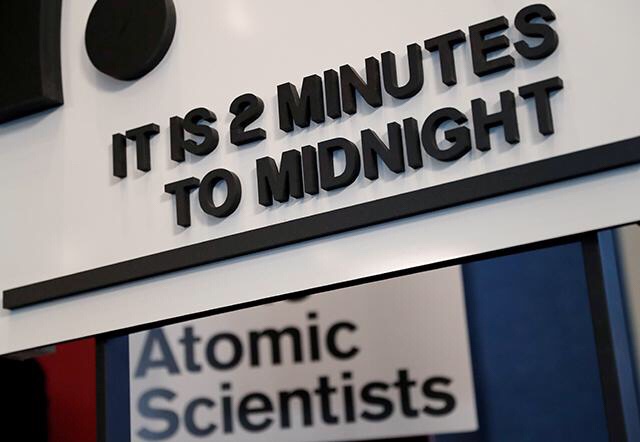 Nuclear arms: We must reverse the direction of the Doomsday Clock
Nuclear arms: We must reverse the direction of the Doomsday ClockIt’s closer to midnight.
Jim Scheibel
Atomic scientists recently announced that it’s 2 minutes to midnight. For them, the world security situation is more dangerous than it was a year ago — and as dangerous as it has been since World War II.
The Doomsday Clock was created in 1947 by scientists for the Bulletin of Atomic Scientists, and uses the imagery of apocalypse (midnight) and the contemporary idiom of nuclear explosion (countdown to zero) to convey threats to humanity and the planet.
Last week the Pentagon released a new nuclear arms policy, effectively ending the Obama-era efforts to reduce the size and scope of the U.S. arsenal and minimize the role of nuclear weapons. The former president called it a moral obligation to lead by example.
During his first State of the Union address, President Donald Trump vowed to build a nuclear arsenal “so strong and powerful that it will deter any acts of aggression.”
The issue of nuclear arms became more real for Hamline students who studied abroad this January in Nagasaki, St. Paul’s sister city. One student remarked, “It is hard to understand the pain when only looking at numbers, but when you see the pictures and hear the stories of survivors, the people affected are not just statistics.”
The course included visits to Ground Zero, the Atomic Bomb Museum, the National Peace Memorial, and seeing “Constellation Earth,” the Paul Granlund sculpture donated by the citizens of St. Paul for the Nagasaki Peace Park. They heard the leader of the International Campaign to Abolish Nuclear Weapons (ICAN), this year’s Nobel Peace Prize recipient. Most moving were the stories of the hibakusha, survivors of the atomic bomb.
To learn about nuclear weapons and create action steps, the Nagasaki Sister City Committee and Nagasaki University sponsored a forum, “Nuclear Issues: Peace and Our Future.” Hamline and Japanese students heard presentations on current research and efforts to end nuclear weapons, followed by intensive discussion and cultural exchange.
Hamline students were surprised to learn from Japanese students how early and to what extent they are taught about the atomic bomb. The Hamline students declared, “Our education has to change.” The U.S. students were inspired by Japanese students who had gone to the U.N. General Assembly to witness the vote on the U.N. Treaty on the Prohibition of Nuclear Arms.
With the minute hand ticking, designing strategies and creating action plans was essential. Working in team, Japanese and Hamline University students developed and presented their plans. Their recommended action included:
Improving education was a central theme and a key to action. At early age information about the effects of nuclear weapons need to be available. A Hamline student has a goal to write a 16-week curriculum for children.
International cooperation among nations, including the United States signing the U.N. treaty on nuclear arms.
The collection of signatures for a petition circulated by Mayors for Peace to support the treaty to ban nuclear weapons.
Starting a tradition in St. Paul of ringing bells at 11:02 a.m. on Aug. 9 each year.
We must reverse the direction of the Doomsday Clock. A Hamline student declared, “I am absolutely convinced that getting rid of all nuclear weapons will be the most important work of our time.” Collectively we must declare, “No more hibakusha”!
Jim Scheibel, a former mayor of St. Paul, is Professor of Practice in the Management, Marketing and Public Administration Department, Hamline University. He is a former director of both AmeriCorps VISTA and the Senior Corps.
No comments:
Post a Comment